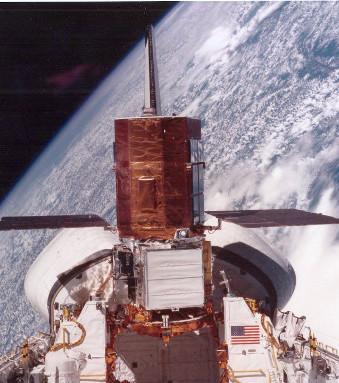Solar Orbiter heritage
NASA and ESA solar observatories
Solar Orbiter represents the next step in a series of impressive large solar observatories installed in space.
Apollo Telescope Mount on Skylab (ATM; NASA, 1973‑1974) — The first US manned observatory in space, with 900 kg of scientific payload, dedicated to investigate the solar atmosphere emission from visible light to X-rays.

The Apollo Telescope Mount on Skylab

Skylab astronauts
Solar Maximum Mission (SMM; NASA, 1980‑1989) — SMM was the first spacecraft repaired in space (1984). The first large observatory, carrying 600 kg of scientific payload, dedicated to investigate the solar explosive phenomena, flares, by detecting the solar spectrum from visible light to γ rays.
Solar and Heliospheric Observatory (SOHO; ESA/NASA, 1995-today) — SOHO is the first observatory to study the Sun for more than two solar cycles, with telescopes operating from visible light to extreme ultraviolet. With its telescopes SOHO observes the Sun 24 hours a day from the Lagrangian point L1 (1.5 million km from Earth) and monitors the heliosphere at L1 with in situ instrumentation (600 kg scientific payload).

The Solar Maximum Mission observatory on the Shuttle during the repair mission
Solar Orbiter (ESA-NASA, 2020-2030) — The first observatory to go close to the Sun (0.28 AU, perihelion) and out-of-ecliptic (beyond 30° helio-latitude) both with telescopes, operating from visible light to X‑rays, and in situ instrumentation.
ESA heliospheric probes
Solar Orbiter is the next step in a series of European probes launched in space to explore the heliosphere.
Helios I & II (ESA, '70s) — Exploration of the inner heliosphere in the range 0.3–1 AU (astronomical unit, i.e., the Sun-Earth distance), the closest to date, with in situ instrumentation to measure the local plasma properties.
Ulysses (ESA/NASA, 1990-2009) — First direct out-of-ecliptic exploration of the polar heliosphere, in the range 1.6–5 AU, with in situ instrumentation to measure the local plasma properties.